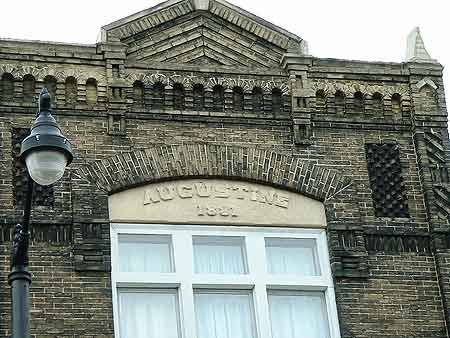Article and photos by Gregory Havel
According to the dictionary, a “cornice” is a projecting horizontal member that tops an architectural component, like a wall or a column. A cornice can be made of masonry with simple or elaborate corbeling (photo 1), or it may be of another material that is attached to the face of the wall (photo 2). The word “cornice” was already used in Europe in the 1500s, although the architectural feature was in use hundreds of years before.
According to the dictionary, a “parapet” is a wall that protects the edge of a platform or roof (photo 3). It is usually made of the same material as the lower part of the wall. The word “parapet” was already used in Europe in the 1500s, although parapets were used in ancient Roman and Greek fortifications thousands of years earlier, for the protection of defenders on top of the main wall.
Not all buildings have parapets. In these, the roof line is at the top of the wall. However, a building without a parapet may have a cornice. Parapets are also installed on the tops of some fire-rated interior walls and project above the roof at these locations.

(1)

(2)

(3)
Since parapets are exposed to the weather on both sides, they tend to deteriorate and weaken more quickly than a wall that is exposed to the weather on only one side (photo 2). This simple fact makes them liable to fail in earthquakes, high winds, and under impact from firefighting hose streams. When they fail, they can collapse onto the roof (endangering anyone who is inside the building on any floor) or onto the sidewalk or street (endangering anyone who is below). When the deterioration of a parapet is advanced, it may lean toward the roof or the outside of the building (photo 3).
A cornice may be installed at the top of a wall at the roof line or on a parapet (photos 1, 2, 3). A cornice may be part of the original building design, or it may have been added later to change the appearance of the building. In any case, a cornice places an eccentric load on the face of the wall, with the result that the wall wants to tip outward toward the street.
A cornice may be made of almost any material: corbeled brick masonry, stone, concrete, terra cotta, wood, gypsum, sheet metal, or plastic. Regardless of what the cornice is made of, when its attachments or supporting wall fails, its weight, combined with the acceleration of gravity, will be enough to cause serious injury or death to anyone below. This fact emphasizes the need for establishing and enforcing collapse zones at structure fires.
The presence and condition of cornices and parapets should be obvious to any firefighter performing an inspection or a size-up. Since incidents are often complex and distracting, these features also deserve a note on the building’s preincident plan.
For a more detailed discussion of cornices and parapets under fire conditions, see Collapse of Burning Buildings by Vincent Dunn (Fire Engineering Books and Videos) or your building construction textbook.
Download this article as PDF HERE and share with other firefighters.
 Gregory Havel is a member of the Town of Burlington (WI) Fire Department; retired deputy chief and training officer; and a 30-year veteran of the fire service. He is a Wisconsin-certified fire instructor II, fire officer II, and fire inspector; an adjunct instructor in fire service programs at Gateway Technical College; and safety director for Scherrer Construction Co., Inc. Havel has a bachelor’s degree from St. Norbert College; has more than 30 years of experience in facilities management and building construction; and has presented classes at FDIC.
Gregory Havel is a member of the Town of Burlington (WI) Fire Department; retired deputy chief and training officer; and a 30-year veteran of the fire service. He is a Wisconsin-certified fire instructor II, fire officer II, and fire inspector; an adjunct instructor in fire service programs at Gateway Technical College; and safety director for Scherrer Construction Co., Inc. Havel has a bachelor’s degree from St. Norbert College; has more than 30 years of experience in facilities management and building construction; and has presented classes at FDIC.
MORE CONSTRUCTION CONCERNS

